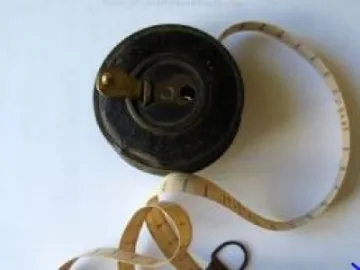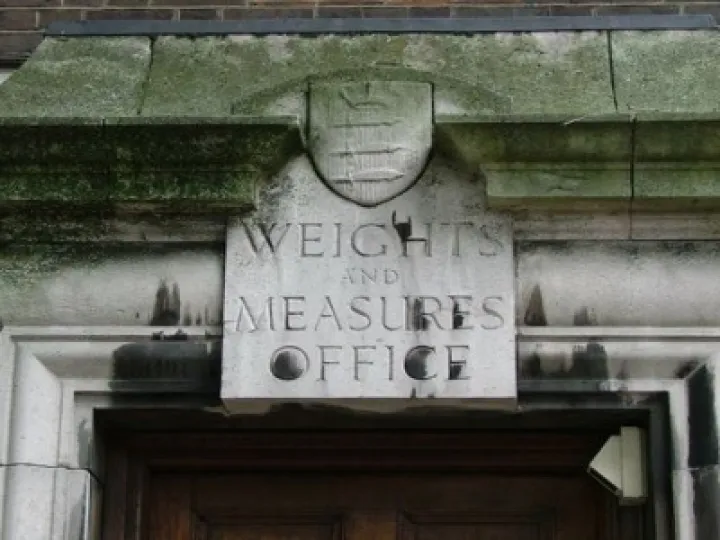Weights and Measures
Until 1965 the UK used the British Imperial system of measurement, since when the metric system has been gradually introduced. So today many weights, lengths and volumes are measured in metric – e.g. kilograms, metres and litres. This is bringing our system into line with that of other countries of Europe. Some of those had the French metric system imposed on them by Napoleon Bonaparte in the early 19th century, when he was Emperor of France.
The British imperial system was complicated, can be traced back to the 5th century and was based on the human body. That seems sensible – the arm, the thumb, the foot, etc are all practical and easy to understand and visualise – until you realise that one person's foot is a completely different length from another! So some sort of standardisation was necessary. Click on a unit of measure, below to find out more.
Length

The basic unit of British measurement of length is the yard, and in the 12th century this was the distance between Henry I's nose and the tip of his outstretched arm.
In the 14th century the English foot became the length of the foot of St Algar, who was carved on the base of a column at the entrance to the old St Pauls Cathedral, which was destroyed in the Great Fire of London in 1666. (No-one knows who St Algar was!). The Romans inherited their 'foot' from the Egyptians and divided it into 12 (inches).
The mile had its origins with the Romans, too. Until the reign of Elizabeth I, a mile was 5,000 feet as the Romans counted a mile as 1,000 paces and a pace was five Roman feet. But then the English mile was changed to 5,280 feet which was equivalent to 8 furlongs. A furlong comes from the old English 'furh' or furrow, and 'lang' (long). It refers to the length of a long furrow that is one rod wide.
Square measure
Originally an acre was one furlong long and one chain wide – in other words it was 220 yards long by 22 yards wide, or 4,840 square yards. (This is about 0.4 of a hectare.) The word acre comes from the ancient English word aecer. Funnily enough, this just meant a piece of land of any size that had been cleared for ploughing or for use by grazing animals. Later it was regarded as a strip of open field that could be ploughed by a yoke of oxen in one single day's work.
The acre as a unit of land was standardized by King Edward I of England who said it was an area of land 40 rods long and 4 rods wide (a rod being 5 and a half yards) and this was built into the Weights and Measures Act of 1824. It was then known as the 'statute' acre. This was because, in other parts of the country, people had continued to measure their acres in different ways. In Lancashire an acre was 7,840 square yards and in Cheshire it was even bigger – 10,240 square yards, or 2.12 times larger than a standard acre.
Old measures can still be found in use in sport. A cricket pitch is 22 yards long, which is one chain. In horse-racing, races are still measured in furlongs, and horses in hands.
Weight

Weights are equally as complicated and have just such a fascinating history. They were based on multiples of a grain of barley and so the smallest amount was known as a "grain". It took 7,000 grains to make up one pound in weight.
The most commonly used amounts, which you will find in the Caldwell ledgers, are ounce (written oz.) and pound (written lb.). The letters lb. are short for the Latin word libra.
Weights are important in understanding money, too. Once upon a time pennies were made of silver and 240 of them weighed one pound. Twelve pennies made one shilling and, pre-decimalisation, our money was often referred to as l.s.d. This stood for Latin words libra (pound), solidus (shilling) and denarius (penny). In the 18th century, when people wrote about money, they often used l to denote pound. Gradually this changed until £ was the common way of showing it. Sometimes amounts were shown one way and sometimes another. So the sum five pounds, two shillings and six pence was sometimes written £5 2s 6d, and sometimes £5/2/6.
Capacity
Although Caldwell's sometimes used weight to show how much seed they were selling, more often it was Capacity that was used. Confusingly, the term ounce is used for both weight and capacity. In weight, 16 ounces equals one pound, but in capacity, it used to equal one pint (and still does in America). So sometimes you will find entries for lbs and other times for pints. But after the Weights & Measures Act of 1824 there were 20 ounces in a pint. Other measures used are quart (equal to two pints), gallon (8 pints), peck (2 gallons) and bushel (4 pecks).

